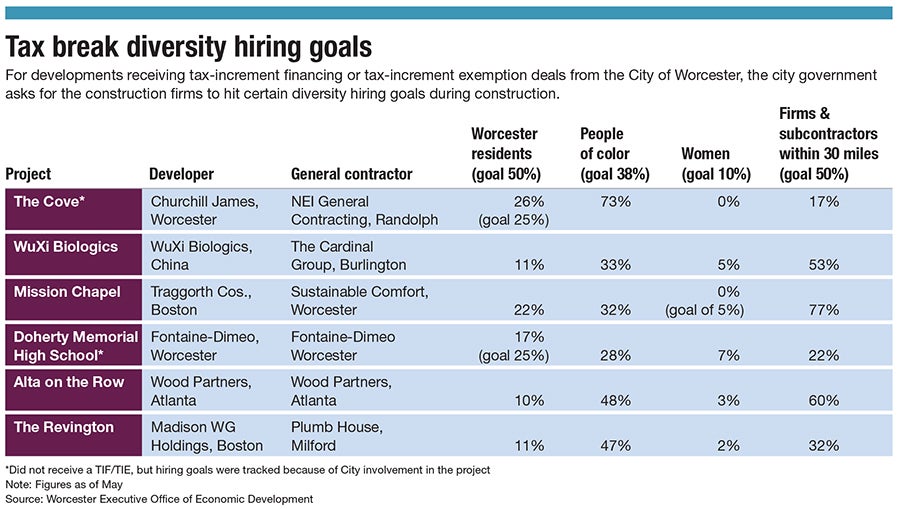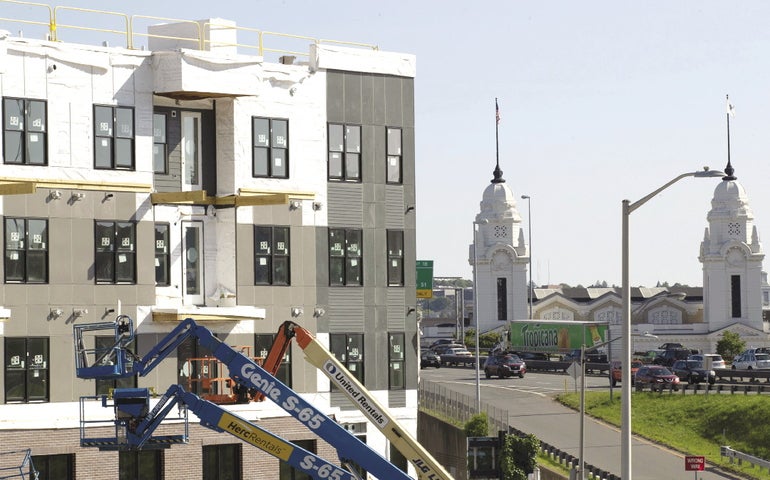The City of Worcester has moved assertively to ensure it is getting a fair deal with developers, placing demands on businesses without reversing Worcester’s development-friendly reputation.
Get Instant Access to This Article
Subscribe to Worcester Business Journal and get immediate access to all of our subscriber-only content and much more.
- Critical Central Massachusetts business news updated daily.
- Immediate access to all subscriber-only content on our website.
- Bi-weekly print or digital editions of our award-winning publication.
- Special bonus issues like the WBJ Book of Lists.
- Exclusive ticket prize draws for our in-person events.
Click here to purchase a paywall bypass link for this article.
When the City of Worcester in April was voting on its new inclusionary zoning policy, housing advocates lined the corridors of City Hall, people made impassioned speeches in the public comments portion of the City Council meeting, and city councilors discussed the need for additional affordable housing versus the fear of cooling the city’s momentum of building thousands of units of new market-rate housing.
Then, when the City Council voted in September to decertify Tennessee-based insurer Unum’s property tax break after the company did not meet the requirements of its agreement with the City, that meeting was much quieter. The council members were in unanimous agreement saying, while the decertification was regrettable, the company was not holding up its part of the bargain.
Over the past year, the City of Worcester has moved assertively to ensure it is getting a fair deal with developers: the decertification of Unum’s tax break, the adoption of inclusionary zoning, and the call for increased enforcement of local and diverse workforce goals. The hope is to strike a balance where certain public goals can be met by placing demands on businesses without scaring them or reversing Worcester's development-friendly reputation resulting in the construction of high-profile developments like the 368-unit 145 Front at City Square, the 228-unit The Revington, and the 370-unit Alta on the Row.

“I would guess that most developers that have completed projects in the past five or so years or are contemplating projects would agree that the City is pro-development,” said Michael Jacobs, principal at Worcester commercial real estate firm NAI Glickman Kovago & Jacobs. “Fortunately, our city government has some very skilled and dedicated employees in the right positions needed by our industry.”
Enforcing tax break requirements
To encourage development, create jobs, and increase property value, the City offers tax-increment financing for commercial projects under the state’s Economic Development Incentive Program. For residential projects, it offers a tax-increment exemption under the state’s Housing Development Incentive Program.
Businesses are offered a tax break on the increased property value that a development creates. For example, if a vacant lot is valued at $1 million and a developer builds a project on that lot that will raise that value to $10 million, the business gets a tax break for a limited time on a portion owed on the $9 million in value that the project is adding. The City does not lose the taxes on the original value.

It’s a very selective policy, said David Sullivan, director of economic development and business recruitment at the Worcester Regional Chamber of Commerce. Around 7,000 businesses operate in Worcester, and the City has 16 active TIF projects including the Unum TIF and five active TIE projects.

The public will not necessarily be aware when businesses ask for but don’t receive a tax break, said City Manager Eric Batista. Many requests are shut down before they make it to the City Council for a public hearing.
“Usually what happens when a developer comes in, is that they’ll ask for a tax break,” said Batista. “We’ll tell them what our priorities are, and they’ll say ‘No, we’re not going to be able to do that for this particular project.’
“When we do present something to the council, it’s because at that point we feel it is something that we’re committed to, something that has a beneficial impact for the community,” he said.

Unum violated its deal with the City when the company decided, independently of the COVID-19 pandemic, to move its employees out of the office building it leases at 1 Mercantile St. in Worcester, which is formerly known as the Unum Building and still bears the company’s sign. The more than 600 full-time employees it had promised Worcester turned into 331 work remotely throughout Massachusetts.
The City Council on Sept. 12 unanimously voted to decertify Unum’s tax break, although the state government still must approve the decertification before it becomes official.
In a statement emailed to WBJ prior to the council vote, Unum claimed to still be in compliance with the original agreement and said the company was working with the City to resolve the problem.
Although the decertification was unusual for the City, which has typically left property tax breaks in place even if companies don’t meet hiring goals, that one decision is unlikely to impact Worcester’s developer-friendly reputation, said Jacobs from the commercial real estate firm.
“The Unum decertification was somewhat of a surprise as I don't believe the City historically has decertified too many properties in similar circumstances,” said Jacobs. “I also don't believe it's a concern for incoming developers.”
Two hotels which received TIF deals, the AC Hotel by Marriott Worcester and the Hilton Garden Inn, have not created the number of jobs they originally promised. However, the City choose not to attempt to decertify those tax breaks, as the COVID-19 pandemic hit the entire hotel industry, making hiring difficult, said Worcester Chief Development Officer Peter Dunn.
Requiring affordability in all new housing
In April, the Worcester City Council voted unanimously to adopt an inclusionary zoning policy requiring multi-family developers to set aside 15% of residential apartment units for households with an income less than 80% of area median income, or 10% of units available to households making less than 60% AMI.
Before Dunn wrote his recommendations, he and his team researched other communities’ inclusionary zoning policies and the results of those policies. They spoke with housing advocates, developers, land-use attorneys, and land-use consultants.

“I’d say where we are at is kind of the average, if you will,” said Dunn. “We came up with what we felt was the best recommendation for our community where we’re at right now.”
Jacobs predicts inclusionary zoning will have an impact on market-rate developers’ decisions to build large-scale multifamily developments in Worcester. Some developers he is working with have told him when they are developing their project’s business plans, they count affordable units at zero or at a loss of income.
With interest rates rising significantly over the last three years and construction materials and labor costs increasing, every penny counts, he said.If those pressures lessen and market-rate rents rise, it will be easier for developers to absorb the missing revenue from affordable units.
“From an affordable housing developers perspective, the IZ has no impact as City and State subsidies are available to them where market rate builders normally burden all the costs without public assistance,” Jacobs said in an email to WBJ.
Worcester’s inclusionary zoning policy might also run afoul of the Massachusetts Executive Office of Housing and Livable Communities MBTA Communities guidelines, intended to increase housing production in areas of the state served by the MBTA. Dunn will have to prove to the EOHLC the inclusionary zoning ordinance does not prevent housing from being built.
The City can adapt the inclusionary zoning policy as needed, Dunn said.
“We want to continue to evaluate and adapt to market conditions because what might be something that the market could withstand in 2022, might not be what the market can withstand in 2024,” said Dunn.
Workforce diversity goals
In 2019, the City Council approved a set of workforce diversity goals on construction projects for developers who receive a TIF or TIE. These goals are meant to encourage developers to hire Worcester residents, people or color, and women, as well as to use subcontractors located within 30 miles of the city. The Worcester Redevelopment Authority, which deals with developers who are given public land for a project, has a similar policy called Responsible Employer and Inclusionary Participation Policy.

The goals have been non-binding, but following two incidents, the city began to seek ways of enforcing the policies. In 2022, Milford general contractor Plumb House refused to submit personnel information to the City to ensure compliance of the hiring goals. Also in 2022, joint venture of Gilbane Building. of Providence and Hunt Construction Group of Indianapolis had to pay $1.9 million in fines because it provided false information about its workforce diversity during the building of the $160-million Polar Park baseball stadium.
Now, the City and WRA are seeking to give teeth to those policies.
“For a long time with the TIF policy and the (WRA’s) REIPP policy, there’s really no interim step for compliance,” said Dunn. “It’s just: Do you want to decertify the TIF or reduce it in some fashion?”
The latest enforcement proposal, which still must be approved by City Council, calls for $5,000 fines and possible reduction of tax break benefits, although developers and construction firms would be given opportunities to return to compliance.
It is no small order to achieve the workforce goals. No TIF/TIE construction projects in Worcester are meeting all of the goals as of June 30, according to Dunn’s semi-annual report.
So many projects happening concurrently in Worcester, it stretches the local workforce, but the city is trying to help to provide more opportunities to join the workforce, Batista said.
“Our biggest commitment to this effort has been the Worcester Jobs Fund,” said Batista. “We invest money in that program to get folks to have opportunities to be educated … {and receive} training and certifications so that they can be connected with these types of jobs.”
Market forces drive development
Despite the City’s more assertive actions toward development, Sullivan said developers feel supported in Worcester.
“Permitting is light years ahead of the Boston area,” he said. “Developers can get a 60-day turnaround.”

Developers still see Worcester as a viable place to build, Jacobs said.
“Worcester is still the hottest market in the state,” said Jacobs. “The City has had a user-friendly approach with all my clients – multi-family or retail – during this unprecedented period of growth.”
The City’s moves won’t be the barrier to development, he said. Larger economic forces are much more impactful.
“Starting at the institutional level down to the local level, most banks are scrutinizing multi-family developments more than in the past. Also, private equity investors are not as bullish on this sector as they were in the past few years,” Jacobs said. “These factors impact most of the industry and will continue to do so until the economy is considered more stable.”

